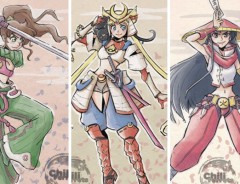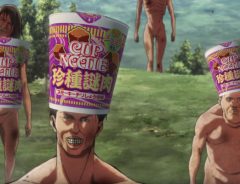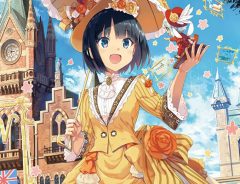- Tags:
- Asahi Shimbun / Asahi Shimbun Publications / Grotesque World / Horror / horror manga / Igyou Sekai / Illustrations / Junji Ito / Manga / Nemuki Comics
Related Article
-

See Your Favorite Sailor Moon Characters As Samurais, Ninjas, And Demon Hunters!
-

Japanese Artist Illustrates The Hilariously Frustrating Daily Life Of A Crocodile In Human Society
-

Artist Turns Fast Food Chain Mascots Into Anime Characters
-

Laid-Back Camp drama’s Nadeshiko and Aoi actresses delight fans with real camping video
-

Attack on Titan’s Biggest Nightmare is a Cup Noodle Titan Invasion
-

Eshi-100 Exhibition of 100 Leading Anime and Manga Illustrators in Akihabara



Acclaimed manga artist Junji Ito has carved out a place for himself in the hearts of horror fans both at home and abroad, based not only on the merits of his manga but also because his works, such as "Uzumaki" and "Tomie," have inspired live-action films and anime (Junji Ito Collection) and have been translated into English as well as other languages.
As we reported earlier this year, Junji Ito is now celebrating 30 years since he made his debut with his first-ever published collection of illustrations in a handsome volume called Igyō Sekai 異形世界 (Grotesque World).
We had the fortunate opportunity to interview Junji Ito and his editor-in-charge, Makiko Hara, at the offices of Asahi Shimbun Publications which published the art book.
(Note: This is an abridged version of the complete full-length interview.)
Photo by © grape Japan
Interviewers: Ben K (grape Japan), Nobushi (Japanese-language media Grape).
The roots of horror: childhood influences
Ben K: Since when have you been interested in horror as a genre?
Junji Ito (Ito): When I was very small, maybe 4 or 5 years old, my two older sisters would read Kazuo Umezu and Shinichi Koga in magazines and I read them too. That was my first experience. I was hooked. I began reading horror manga after that.
Nobushi: Kids that age scare very easily. But you were fine with it?
Ito: Yes. The manga I was reading wasn't that scary. On the other hand, TV shows where they went into haunted houses or had a medium who could summon spirits, I thought those were scary. Interesting, but scary. I was scared by things that seemed real to me. I couldn't go to the bathroom by myself after that. Especially since the bathroom in my house was at the end of an underground tunnel. As for manga, of course, some of it was scary but for the most part, I found it interesting and intriguing. I loved Kazuo Umezu's drawings. Strange creatures, the grotesque. They fascinated me, so I enjoyed reading his manga. But that bathroom was scary...
Ben K: And if you had to go underground, there must have been insects, like centipedes and the like?
Ito: That's right. In my house, when you went down into the tunnel, we had a storage shed there with an earthen floor. Today, the foundation would be concrete but, in those days, it was exposed earth. And spider crickets would often be there. They look like crickets but they have spotted bodies, rounded backs and very long legs, with which they would jump all over the place as soon as you got near them. They really frightened me.
Ben K: I can imagine. So, such experiences were later reflected in your manga.
Ito: They were indeed.
On Tomie
Photo by © grape Japan
Ben K: One of your most famous series, as well as your debut work, is “Tomie.” Was there any inspiration for Tomie in real life? A model, for example?
Ito: No, I’m afraid there wasn’t a beautiful woman who was the model. When I was in junior high school, a boy in my class died in a traffic accident. It just felt so odd to me that a classmate who was so full of life should suddenly disappear from the world, and I had the strange feeling that he would show up again innocently. Ever since then, I wanted to give expression to that feeling in my manga. That’s how I came up with the idea of a girl who is supposed to have died but then just shows up as if nothing had happened. In real life, it was a boy who died, but I turned her into a girl in the manga.
Ben K: I see. "Tomie" was first serialized in a girl's magazine called Gekkan Halloween 月刊ハロウィン (Monthly Halloween). She manipulates men, drives them crazy, yet comes back to life again and again no matter how many times she is hacked into pieces or killed in any number of violent ways. Why do you think such a character was so popular with the primary audience of girls who read "Tomie" in Gekkan Halloween?
Ito: Well, immortality, never dying, is something I think everyone longs for. At some point, we all wish we could be immortal. But Tomie lives her life completely as she wishes. She's haughty yet she captivates men. I imagine women have this desire to act like a princess. They envy Tomie's freedom, that's what I think...
Ben K: Was there anything confirming that in the fan letters your readers sent?
Ito: Yes, there was. Some girls even wrote that they were aspiring to become Tomie (laughs).
Photo by © grape Japan
On Gyo
Ben K: Now, I'd like to ask you about "Gyo." Ultimately, the creatures seem to take over Japan and I feel it's implied that they will eventually take over the world. But in the beginning, they were born out of chemical weapons experiments. Considering these origins, was there an anti-war message in depicting monsters like this?
Ito: When I was a child, my parents, who were of the war generation, would tell me tragic and frightening war stories, so I naturally developed a strong awareness of war as a scary thing. What's more, as a boy, I was afraid I would be drafted as a soldier when I grew up. This fear of mine naturally developed into anti-war feelings, and I think this is reflected in my work.
Ben K: "Gyo" is quite a remarkable work with many fans. The fusion of organic and inorganic, and an uncanny sense of agency as well...
Ito: I wanted to tell the story so that the mastermind behind the phenomenon would remain a mystery... It was quite a while ago, so I can't remember it too well now, but one of the characters gives it away at the end. If I had extended the story, I would have been able to flesh it out further... but I exhausted my energy on it.
Personal favorites
Ben K: Looking at your body of work so far, do you have any personal favorites?
Ito: "Long Dream," "The Hanging Balloons" and "The Enigma of Amigara Fault." I would say those are my favorites. I don't think I'm very good at long stories, so I don't have any which I'm personally satisfied with. Short stories are easier to write well, and I’m happy with those three.
Ben K: I personally liked "Long Dream." It has a strong science fiction element to it. Were you inspired by any specific work of science fiction?
Ito: When I was a kid, my eldest sister told me something she had learned: When you're sleeping and have a dream, you feel time passing by, but for someone looking at the dreamer objectively, the dream only takes an instant. I did some research online recently, and it seems that this used to be a major theory. I think they called it the "instantaneous generation" theory. I was fascinated with this notion. I imagined that if you could have a dream that lasted for a considerable duration, it might be possible to have a very long dream in an instant as well. At first, I thought I could make it a science fiction story. I used to love science fiction in middle school, and I created short-short stories under my name. But I only got through the beginning before I stopped (laughs). It was an interesting topic, however, so I came back to it, this time as horror. That's how the story came to be.
Fascination with the grotesque
Nobushi: What is it about the grotesque that appeals to you?
Ito: It could be that my curiosity is stronger than my fear or perhaps I just have bad taste (laughs). It's something a bit different from human, not animal either and yet exists in our world. It spreads in rumors and remains a mystery. In the past, rumors about such things as kuchisake onna 口裂け女 {an urban myth about a woman with a split mouth who kills passersby} were common. The rumors spread first before any verifiable facts. I find that thrilling. So, for me, rather than scary, those things are thrilling and fascinate me.
Nobushi: Is it also the mystery of it that you find interesting?
Ito: That, and the fact that these are products of our imagination. I find it interesting that humans have such powers of imagination. Demons, for example, may have had a model inspiring them, but yōkai 妖怪 {Japanese monsters} come in so many varieties, and their forms can be very interesting. It is said that yōkai are inspired by particular human characteristics which are then exaggerated. There's something fun in peeking into a world which exists outside of our everyday experience.
Photo by © grape Japan
On the anime series Junji Ito Collection
Ben K: I'd like to change topics now to the anime series "Ito Junji Collection." What is your impression of how it turned out?
Ito: Shinobu Tagashira was the director. She really likes my work and respects it. In the way she expressed the mood of the manga, told the stories, and handled the look, I got the impression that she took great care in handling my work. In fact, I think some episodes turned out even better than the original.
Ben K: For example...?
Ito: Well, there's a story called: "Lingering Farewell." It's a tearjerker, but the way she did it, you'll cry even more than the manga. The music was wonderful, too. Also, I think she did a fantastic job with the Sōichi series. The voice actor for Sōichi was superb. Yūji Mitsuya. He's a veteran voice actor whose work I've been familiar with for many years...
Nobushi: Did you have a say in the process? I mean, in deciding which voice actor should handle which character?
Ito: For "Tomie," we had an audition, and I was there for several candidates. At the end, we narrowed them down and I made the final decision. I thought she had class. Tomie's language is a little bit old-fashioned, and this voice actress spoke Tomie’s lines with an intonation reminiscent of the Showa Era. So, I felt that she might be a good choice.
On Junji Ito's first artbook, Igyō Sekai (Grotesque World)
Ben K: I'd like to ask you about your recently published art book. This is your first one. Was there a reason behind the timing of its publication?
Ito: 30 years have passed since I began creating manga, so this book was produced as a 30th year commemorative project. Hara-san was in the charge of everything...
Photo by © grape Japan
Hara: Yes, it was a 30th year commemoration, but there's more to it. Mr. Ito's works have been translated a lot outside of Japan. So, in addition to commemorating Mr. Ito's 30th year, I also had foreign language translation in mind when I planned the book.
Ben K: So then, you already have plans for translated versions?
Hara: We do. Although I cannot disclose any details at this time, we are already in talks with several countries with regards to translations.
Ben K: As for the art images, did you have criteria in selecting which ones to include?
Hara: At first, I thought I'd like to include everything, if I could. But I learned very early on that it was impossible to include everything (laughs). Some of Mr. Ito's works are no longer in his possession and I soon realized that we couldn't obtain them. Therefore, we changed the concept to collecting all originals, pieces which weren't based on works by other authors. That's why we didn't include "No Longer Human" or "Rasputin the Patriot." So, that was our criteria: original-only pieces, and as broad a selection as possible. Also, from the beginning, Mr. Ito and I wanted the book to properly convey the appeal of black and white prints, so we also accentuated that.
Photo by © grape Japan
Future plans
Ben K: Going forward, is there a kind of manga you'd like to create, or, not limited to manga, something new you'd like to try?
Ito: Well, when it comes to manga, I don't have long-term aspirations about some grand scale project I'd like to create. I'm more about devoting all my energy to the work that's in front of me. If I had to say something, I would like to create more short works I can be satisfied with. As for non-manga projects, take this art book here. The cover is an original I drew. I'd like to draw more single works, illustrations, like this. Recently, I've been mostly working with digital tools, but doing things the analog way, drawing on paper like old times is enjoyable for me, so I'd like to do more.
Ben K: Does that mean we will be seeing more exhibitions in the future?
Hara: Yes. In addition to art galleries in Tokyo where Mr. Ito's works are occasionally exhibited, he also makes international appearances. For example, at the end of August in San Jose, Mr. Ito is invited to the Crunchyroll Expo, where there will be a gallery of original works, and goods will be sold. Mr. Ito will also bring original drawings from his manga, and those will also be displayed.
Ben K: I'm sure fans will be pleased... Mr. Ito, your works have been adapted to live action film before by Japanese directors. If you were able to work with a foreign film director on a future project, do you have any names that come to mind?
Ito: Hmm... An Italian director who was active in the 1970s... He's quite advanced in age now... Dario Argento, famous for "Suspiria." I think he would film women very beautifully. Of course, this is just my own personal wish (laughs). And also, William Friedkin, director of "The Exorcist"... He's also quite advanced in age... I don't know young directors very well.
Ben K: Thank you very much for your time.
Photo by © grape Japan
Link to full-length interview.